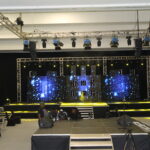
Communication ceases with unintelligible audio. From the boardroom to the training center to the huddle rooms scattered across a facility, poor corporate sound is a common source of complaints and frustration. While malfunctioning hardware and user error can be addressed, muddy, indistinct sound is a much more vexing problem for the IT department responsible.
Let’s start by clarifying what we mean by “great sound” in typical situations like phone conferences and meetings. Intuition suggests that a WYSIWYG approach should work. Capture and reproduce corporate sound sources accurately, and everything should be fine, right?
Sadly, no.
Great Corporate Sound vs Great Live Music Sound
What defines great sound depends on the situation and context. For example, music and speech have very different requirements. In music, great sound is about fidelity, but great sound for the spoken word is about ease of understanding, or intelligibility. A sound system designed to maximize one will often be problematic for the other.
In a corporate environment, speech intelligibility is mission critical. If the listeners can’t understand the talker, the meeting or teleconference becomes inefficient and ineffective.
We’ve all experienced poor speech intelligibility. The most common example is talking in a noisy room, like a crowded restaurant with background music, or a highly reverberant house of worship with lofty ceilings and reflective walls. It’s very common for meeting and conference rooms to have extremely reflective surfaces like concrete, glass and whiteboards, creating a lot of reverberation and reducing clarity. Similarly, unwanted ambient sound within the room can be a problem.
Speech intelligibility—the listener’s ability to easily understand the talker—requires direct sound, spoken word in this case, to overpower both unwanted ambience (HVAC, projector noise, etc.) and reflected sound (room reverberation). The good news is that knowing how to optimize the deployment of system elements like microphones can be a big help.
Conferencing Microphone Basics
Let’s focus on one of the more difficult situations: audio and video conferencing, where the sound in your local room is heard by distant participants. Most teleconferencing systems, whether a single-mic, computer-based solution like Skype For Business, Webex, or LinkedIn, or a multi-input system for joining multiple locations, incorporate a digital audio codec, usually with an external digital signal processer (DSP) that includes acoustical echo cancellation (AEC) to ensure smooth communication. Even with these mitigating factors, teleconferencing systems are still subject to audio issues like room noise and reverberation.
At the beginning of your teleconference, check with distant participants to see if they can hear your location clearly. If the overall sound quality is hollow, muffled, or indistinct, unwanted sound is likely the problem. Fortunately, there are things you can do to help.
Critical Distance
Let’s start with the concept of critical distance, which is the distance between the sound source and the microphone at which the direct sound (the talker) and ambient noise are at the same volume level. For good intelligibility, it is key for talkers to be significantly closer to the microphone than the distance at which critical distance is achieved. The more unwanted ambient sound in the room, the shorter the critical distance. For more details on critical distance, check out our product support team’s explanation in this FAQ.
Unidirectional Polar Patterns
One of the most effective ways of reducing unwanted sound is to use microphones with a unidirectional polar pattern. Types of unidirectional patterns include cardioid (heart-shaped) and supercardioid. These mics are most sensitive to sound from the front and least sensitive to sound from the rear.
If you talk into a unidirectional microphone from the front, then slowly rotate the mic 180 degrees, you will notice that it picks up less and less of your voice. This is by design. Properly aimed, unidirectional mics can help reduce ambient noise pickup of room reflections as well as environmental buzz, hum and fan noise. In general, look for tighter polar patterns in difficult acoustic spaces. Omnidirectional microphones are not recommended.
Microphone Form Factor
Once you’ve chosen an appropriate polar pattern, it’s about choosing the most effective form factor. For the greatest intelligibility, you want to get the mic as close to the talker’s mouth as possible. Headworn microphones are perfect for this task, but some people find them distracting to wear. The next best alternative is a lapel, or lavalier, microphone clipped to the clothing. Unfortunately, most people prefer not to wear their microphones, which is understandable.
This brings us to the realm of tabletop microphones. These could be low-profile boundary microphones like the MX395 or gooseneck microphones like the MX405 and MX412. Gooseneck microphones (again, with a cardioid or supercardioid polar pattern) have an advantage over boundary microphones in that they’re positioned closer to the talker and farther from table noise like shuffling papers. When using flat, surface-mount boundary microphones, be sure the mics are not blocked by laptops or papers, and remind conference participants to sit close to the table




